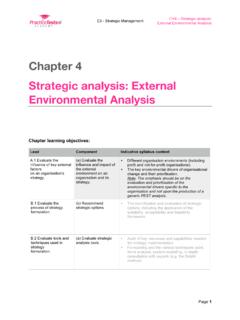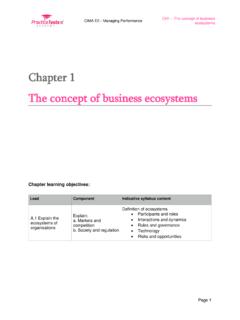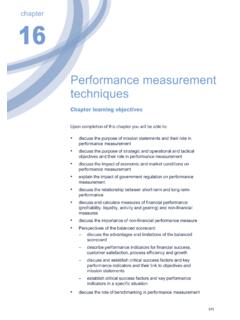Transcription of E3 CH8 The performance measurement matrix
1 E3 - Strategic Management ch8 the performance measurement matrix Page 1 Chapter 8 The performance measurement matrix Chapter learning objectives: Lead Component Indicative syllabus content Evaluate the tools and techniques of strategy implementation. (a) Evaluate alternative models of strategic performance measurement in a range of business contexts. Alternative strategic business unit (SBU) performance measures, including shareholder value added (SVA) and economic value added (EVA). Alternative models of measuring strategic performance ( the Balanced Scorecard (BSC) and the performance pyramid as strategic evaluation tools). (b) Recommend solutions to problems in strategic performance measurement Setting appropriate strategic targets through the use of a range of non-financial measures of strategic performance and their interaction with financial ones. Evaluation of strategic targets through the development of critical success factors (CSFs).
2 Linking CSFs to Key performance Indicators (KPIs) and corporate strategy and their use as a basis for defining an organisation s information needs. Effective communication of strategic performance targets, including the need to drive strategic performance through stretch targets and promotion of exceptional performance . The role of the Chartered Management Accountant in the process of strategic performance evaluation. E3 - Strategic Management ch8 the performance measurement matrix Page 2 1. The performance measurement mix This is important for two reasons: 1. It enables the management to identify whether the strategy is having the desired effect on the organisation s output. 2. Setting performance targets is a way of communicating targets to staff and other key stakeholders that indicate the organisation s priorities. This way, rewards can also be linked to the achievement of these measures.
3 2. critical success factors and their link to performance measurement One useful way of generating a performance measurement mix for the organisation is to identify critical Success factors that are determined by the strategy. critical success factors are a limited number of areas in which results, if they are satisfactory, will ensure successful competitive performance for the organisation. CSFs tie into the organisation s overall strategy. The CSF would then be translated into Key performance Indicators (KPIs). Note: KPIs are specific, measurable targets that can be used to assess whether the CSFs have been achieved. A strong performance measurement mix is likely to reflect CSFs and KPIs identified by the organisation, as they are the key areas in which the organisation needs to do well in order to outperform its rivals. This is the key issue for most businesses. Key points: Whatever the organisation chooses as its performance measurement mix: It will need to be monitored going forward.
4 Management will need to ensure that information systems are put in place to collect data to allow performance in these areas to be monitored on an ongoing basis. Along with the organisation s KPIs, the performance measurement mix is likely to cover a wide range of criteria both financial and non-financial. Changes to the performance measurement mix When changing the performance measurement mix, management needs to be aware of the following points: Too many changes may lead to indicator overload, confusing employees about what the company wants to do. E3 - Strategic Management ch8 the performance measurement matrix Page 3 If something is included as part of the performance measurement mix, the importance of that item is being highlighted to staff. If a measure is dropped from the mix, you are communicating to staff that this item is no longer needed. 3. Financial and Non-financial measures Financial performance measures Financial performance measures concentrate on the profit made by the business and the assets used to generate those profits.
5 Financial performance Indicators Indicators Formula Explanation Sales margin/Gross Profit margin 100 Focuses on the profitability of the business trading account Net profit margin & 100 Focuses on the profitability of the business in both trading and its net operating expenses Return on capital employed & 100 Capital employed = Shareholder funds + Long-term debt Measures the profitability of a business or division against the assets utilised in the business Advantages of financial performance measures Disadvantages of financial performance measures Culturally expected Inflation distortion Focus on financial objectives Lead to suboptimal and short-termist behaviour Comparable across companies Lack of comparability Cheap Understood by the select few trained accountants and managers Established framework for preparation in many cases Subjectivity can exist in calculation depreciation and amortisation Tend to focus on resource generation and so survival in the long-term E3 - Strategic Management ch8 the performance measurement matrix Page 4 Non-financial performance measures Businesses need to focus on the factors that actually cause profits to be earned non-financial measures.
6 If the performance in these areas began to fall, it would not be long before the financial performance measures would also deteriorate. Advantages of non-financial performance measures Disadvantages of non-financial performance measures Wider view Some can be difficult to calculate Easier to calculate Subjectivity exists in design, interpretation and calculation Easier to understand Can lead to indicator overload Not distorted by inflation Costly Can emphasise broad spectrum of management Culture clash implications Positive motivational implications Constant changes require constant monitoring 4. The Balanced Scorecard Kaplan and Norton The aim of the balanced scorecard is to provide a broad range of both financial and non-financial measures designed to reflect the complexity and diversity of business circumstances. Financial perspective To succeed financially, how should we appear to our shareholders?
7 Internal business processes To satisify our shareholders and customers, what business processes must we excel at? Customer perspective To achieve our vision, how should we appear to our customers? Learning and growth To achieve our vision, how will we sustain our ability to change and improve? Vision and Strategy E3 - Strategic Management ch8 the performance measurement matrix Page 5 It is a powerful tool that assists in the running of an organisation. Gains in one area need to be considered in conjunction with the losses that may arise in other areas and vice versa. The manager s view is then broadened, and the tendency to concentrate on one measure is reduced or hopefully removed. Explanation: The balanced scorecard is an approach to the provision of information to management to assist strategic policy formulation and achievement. Emphasises the need to provide the user with a set of information that addresses all relevant issues of performance in an objective and unbiased fashion.
8 The information provided includes both financial and non-financial elements and covers areas such as profitability, customer satisfaction, internal efficiency and innovation. It was a response to traditional performance measurement , which had tended to focus on a narrow range of performance measures and caused management to adopt a short-term focus. Strategy mapping implementing the balanced scorecard effectively This was developed by Kaplan and Norton as an extension to the balanced scorecard. The purpose was to make implementation of the scorecard more successful . The steps involved are: 1. Identify the overriding objective of the organization. 2. Determine the main way the organisation will create value, given its overriding objectives. 3. Identify strategic objectives to support this financial perspective. 4. Clarify customer-oriented strategies supporting the overall strategy = customer perspective.
9 5. Identify how internal processes will support strategies = internal perspective. 6. Identify skills and competences needed to support strategies = learning and growth perspectives. E3 - Strategic Management ch8 the performance measurement matrix Page 6 Note to remember: The strategy map helps the organisation to clarify, describe and communicate the strategy and objectives, both within the organisation and to external stakeholders, by presenting the key relationships between the overall objective and the supporting strategy and objectives in one diagram. Difficulties: Organisations have often found it difficult to translate the corporate vision into behaviours and actions that achieve the key corporate objectives In practice, many employees do not understand the organisation s strategy, and systems such as performance management and budgeting are not linked to strategy. Benefits and drawbacks of the balanced scorecard Benefits Drawbacks Avoids management reliance on short termist or incomplete financial measures.
10 Does not provide a single overall view of performance . Identification of non-financial measures helps management to identify problems earlier. There is no clear relationship between the balanced scorecard and shareholder analysis. Ensures that divisions develop success measures for their divisions that are related to the overall corporate goals of the organisation. Measures may give conflicting signals and confuse management. Can assist stakeholders in evaluating the firm if measures are communicated externally. A substantial shift in corporate culture is often required in order to implement it. E3 - Strategic Management ch8 the performance measurement matrix Page 7 5. The performance Pyramid The performance Pyramid Framework Lynch & Cross A model to understand and define the links between objectives and performance measures at different levels in the organisation. Designed to ensure that the activities of every department, system and business unit support the overall vision of the organisation.












